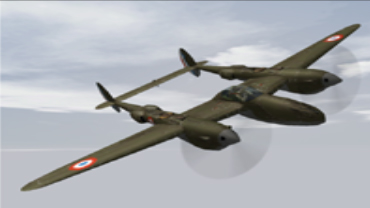Difference between revisions of "Lockheed 322-15 / P-38F"
(Created page with "=Lockheed 322-15 / P-38F Lightning= {| class="wikitable floatright" | colspan="2" style="text-align: center;" | 400px |- style="background:#666600; c...") |
m (Eddie05 moved page P38 to Lockheed 322-15 / P-38F) |
(No difference)
| |
Revision as of 11:44, 12 February 2023
Lockheed 322-15 / P-38F Lightning
History
The Lockheed 322-15 was a P-38F in foreign export service. In 1940, the French Air Force ordered hundreds of these excellent twin engined fighters which at the time were considered a very avante garde design. The planes could not be delivered in time before France was out of the war in Western Europe, and while there were other mitigating factors preventing deliveries to match orders taken from overseas, eventually some made their way to England where they were rejected due to poor performance. In retrospect, as these were downgraded versions with asymmetric engines and no turbo superchargers this was hardly surprising.
The centerline guns package was very deadly, with almost unparalleled firepower due to the extremely tight grouping of the heavy caliber guns.
The P-38 did not garner a stellar reputation in Europe at first, as pilots near froze to death because of inadequate cockpit heating, but in the lower warmer air of the Pacific theater it carried the highest scoring American aces of all time to their deadly work.
Gameplay
While there is no denying the deadly effectiveness of four .50 caliber heavy machine guns and a 20mm cannon all mounted and firing from within a 4 foot circle, there are some elements of the P-38’s performance that are harder to grasp. Not a beginner’s plane by any stretch, the P-38 shines most brightly at high speed. Its acceleration is slow compared to the FW 190 it has to face off against during most Battleground Europe campaigns, but it is one of the fastest fighters in the game and dives like a greased banshee as most American aircraft are known to do. Its rate of climb rate is average, falling well short of the Bf 109-F and Bf 109-G at all altitudes. For this reason the careful P-38 pilot begins his mission by securing an altitude advantage, climbing to at least 6 km before heading in to “Indian Country”.
With the ability to run down all but the most carefully piloted FW 190 also comes an ability to haul the big bird around in tight circles. Owing to its relatively glacial roll rate most P-38 pilots tend to keep it in a single circle and reverse in the vertical as necessary. However, its slow rate of roll can be increased by going into a “snap roll”, a manoeuvre that gives it an unsurpassed dogfighting capability. The snap roll cannot be used at any juncture though. It is best performed in a typical dogfight speed range between 200 and 350 km/h, by swiftly adding full elevator input to full aileron. E.g, push the stick hard over and hold it to the side while pulling the stick “down to the corner”. Release back pressure half-way through the manoeuvre and neutralize the stick fully to stop rolling. Practice extensively to get a feel for the timing and exit direction of this manoeuvre, as it can be rather disorientating to roll so swiftly.
Its dogfighting capability is further enhanced by utilizing the excellent and advanced Fowler type wing flaps which, with judicious deployment, improve your turn rate to a very significant degree. Combat flaps works wonderfully in combination with the generous horsepower boost you get by using War Emergency Power (WEP, F8 key on/off). Your reserve of WEP is considerable and gives the P-38 a significant performance edge in rapid ascents and sustained combat. It is however inadvisable to fly with the flaps deployed for any extended period, as the improved turn benefit comes at a price of huge amounts of drag that slows you down to the point of helplessness. Ideally you should only deploy flaps for a few seconds at most, sufficient to buy you angles for a guns position.
Like all American aircraft the P-38 has a generous operational endurance. This is a curse early on in the sortie as the fuel weights you down and limits your freedom of action, but a blessing later in the sortie as the void increases your manoeuvrability by a wide margin.
No P-38 alone can deal with large numbers of enemy however. Therefore the wise pilot flies the P-38 in pairs with a wingman, or in a group of four to offer mutual support and visual security. It is generally best to stay fast and use your speed and the deadly hard hitting guns package to do the job, and to avoid sustained turning fights unless you have the enemy outnumbered by a comfortable margin.
| Air Units in Battleground Europe | |
|---|---|
| Fighters and fighter bombers | |
| Bf 109E-1 | Bf 109E-4| Bf 109E-4B |Bf 109F-2 | Bf 109F-4 | Bf 109G-2/R1| Bf 109G-6/U4 | Bf 110C-4 | Bf 110C-4/B | Blenheim IF | Dewoitine D.520 | Fw 190A-3B | Fw 190A-4 | Hawk 75 | Hawk 81 | Hawk 87 | P-40F Kittyhawk Fighter Bomber | | Hurricane Mk I | Hurricane Mk IIb | Hurricane Mk IIc | Hurricane Mk IID | Junkers 87G2 'Stuka' | P-38 'Lightning' | Bell Model 14a / P-400 Airacobra | Model 26 / P-39N Airacobra | Spitfire Mk Ia | Spitfire Mk IIb | Spitfire Mk Vb | Spitfire Mk IXc | |
| Bombers | |
| Blenheim IV | Douglas DB-7 | Havoc Mk.I | A20C Havoc | Heinkel 111 | Junkers Ju 88A4 | Junkers 87 'Stuka' | | |
| Transport | |
| C47 'Skytrain' | Junkers 52 | |
